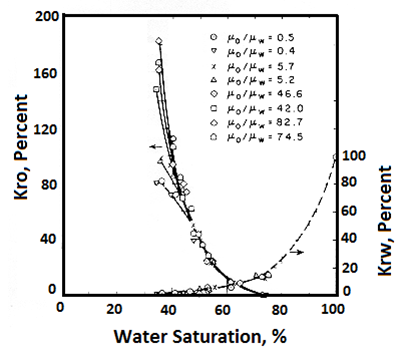Fundamentals of Fluid Flow in Porous Media
Chapter 2
Relative Permeability
Three Phase Relative Permeability: Effects of Viscosity on Relative Permeability
Researchers still haven’t reached a conclusion regarding the effect of viscosity on relative permeability. A number of researchers report that viscosity does not affect relative permeability at all, while others say that it does.
Sandberg and Gournay studied the effects of oil viscosity on relative permeability of sandstone outcrop. They reported that the relative permeability of both phases is not a function of the nonwetting phase viscosity Odeh mentioned that Leverett had shown earlier that the wide range of viscosity had essentially no effect on relative permeability[26]. Odeh developed a two-phase flow model which assumed that the porous medium consists of straight circular capillaries of different radii. He also assumed that there are no interconnections among the capillaries and no mass transfer across the oil water interface. During waterflooding, a layer of water is left between the oil and the walls of the capillary[26]. The model is as follow: Where, kro = relative permeability of oil μo = viscosity of oil μw = viscosity of water m = total number of capillaries in porous sample n = number of capillaries through which one phase flow k = a constant εn = thickness of water film = rc – rn rc = radius of any capillary rn = radius of oil phase in the capillary In Odeh’s model, This equation indicates that relative permeability to oil is a function of saturation as well as the viscosity ratio, the thickness of the molecular layer and pore sizes. Odeh performed experiments to investigate the effects of viscosity ratio on the relative permeability of the nonwetting phase ( kro ). The results are shown in Figure 12. The figure shows that the maximum differences in relative permeability values due to viscosity ratio variation occur at the point of minimum brine saturation. This increase tends to a limit as the viscosity ratio becomes larger. As mentioned before, Sufi et al. found that as temperature increases, viscosity ratio ( oil to water ) decreases, which changes the fractional flow of water and oil[21]. This in turn changes the relative permeability curves. Thus it is possible that viscosity ratio does affect the relative permeability curves. [6] Sandberg, C.R. and Gournay, L.S., “The Effect of Fluid-Flow Rate and Viscosity on Laboratory Determinations of Oil-Water Relative Permeabilities”, Trans., AIME (1958) 213, 36-43. [21] Torabzadeh, S.J. and Handy, L.L., “The Effect of Temperature and Interfacial Tension on Water/Oil Relative Permeabilities of Consolidated Sands”, SPE 12689. [26] Odeh, A.S., “Effect of Viscosity Ratio on Relative Permeability”, Trans., AIME (1959) 216, 346-353. If you have any questions at all, please feel free to ask PERM! We are here to help the community.

 is a series in rx / ro where rx is the radius of the smallest capillary which is filled with oil at an oil saturation So.
is a series in rx / ro where rx is the radius of the smallest capillary which is filled with oil at an oil saturation So.
Figure 2-96: Effect of Viscosity on Relative Permeability (After 26)References
Questions?
